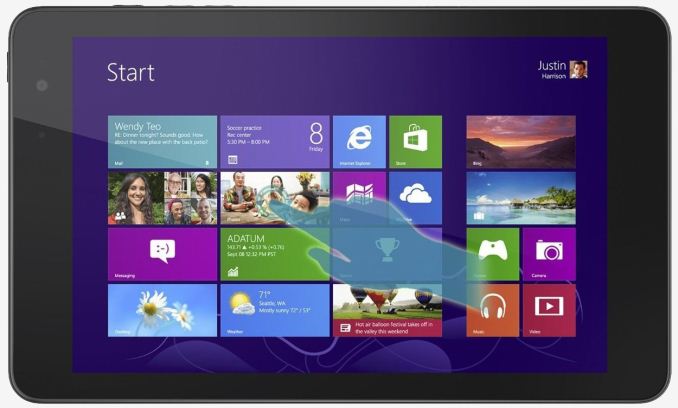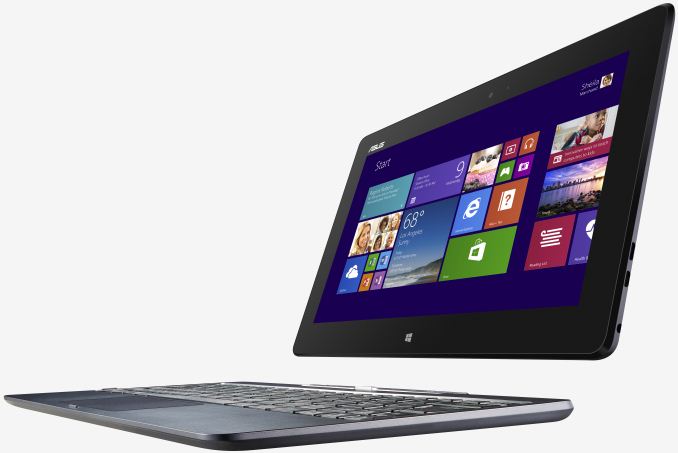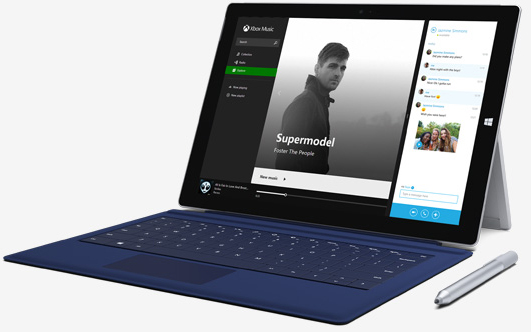Best Tablets: Holiday 2014
by Brandon Chester on November 28, 2014 8:00 AM ESTWindows Tablets
In the early days of Windows 8 tablets, users had to decide between ARM based devices running Windows RT or x86 devices running the standard version of Windows 8 that you would get on a desktop computer. At this point it's fairly safe to say that Windows RT was an utter failure and is dead as a platform. Removing support for every piece of legacy software effectively removed the appeal of running Windows, and efficient x86 processors from Intel have closed the battery life gap between ARM and x86 in the tablet form factor.
For that reason, we haven't seen any big Windows RT tablet launches, and there aren't any that are worth recommending. However, there's a surprisingly large range of prices for Windows tablets, and many double as laptops through convertible designs or keyboard and trackpad attachments. Due to the unique nature of the Windows tablet space, our recommendations here address both price points and special cases of 2-in-1 laptop and tablet hybrids.
The first Windows tablet on our list also happens to be the least expensive of all the tablets. It's HP's recently launched Stream 7 tablet, and it sells for just $119. It's currently available for $20 less at Microsoft's online store, bringing the price down to $99. Before we talk about the tablet itself, it really needs to be stated that it's amazing to see a device running full Windows, and with a full year subscription to Office 365, for $99. Not long ago that $99 would have gotten you a copy of Windows, or a copy of Office. Now you get both, and HP basically throws in a tablet.
The tablet itself isn't bad either, at least relative to its price. Obviously concessions are going to be made to achieve such a low price point, the largest of which is the use of only 1GB of RAM, which will definitely be a limiting factor even on 32-bit Windows 8.1. The omission of 802.11ac is also unfortunate but entirely expected. The rest of the specifications are quite respectable for this price point. The display is a 7" 1280x800 IPS LCD, and the CPU is Intel's Atom Z3735G, a quad core 1.33GHz Bay Trail part with a 1.86GHz burst frequency. For storage you get a 32GB SSD, although it should be noted that a large portion of that is used by Windows. This doesn't leave a lot of space for local files and programs, but it's called the Stream 7 for a reason.
Obviously the Stream 7 isn't going to replace a high end laptop or desktop any time soon. But for someone who needs to have some sort of Windows software available quickly in a small package, it's definitely a good option. I'm interested in it just for the ability to run MPC-HC and madVR on a tablet that can be fueled by videos both in the cloud and on MicroSD storage.
Users looking for a higher end Windows tablet that is still relatively affordable should take a look at the Dell Venue 8 Pro. Normally $299, this tablet is available for $199 from Microsoft's online store during the time surrounding Black Friday. That price gets you similar specifications to the Stream 7, with 32GB of eMMC NAND, a 1.33GHz quad core Atom Z3740D, and an 8" 1280x800 IPS LCD. The biggest improvement is the shift to 2GB of DDR3L-RS memory, clocked at 1600MHz vs 1333MHz in the Stream 7. There are also improvements to the cameras, although I haven't really covered the cameras in any detail with this guide because I don't think they're really a selling point for most people. Without being able to measure the display, it's hard to say if the Venue 8 Pro is worth the premium over the Stream 7 at its normal price of $299. However, at its current sale price of $199 it's definitely worth considering due to the RAM increase alone.
Next up is the 2-in-1 category. I've never really been a fan of devices that try to turn laptops into tablets or tablets into laptops. I find they usually just let me down by not having sufficient hardware to do any sort of productivity tasks where I would appreciate the keyboard input. But for users who just want to have the option to type some notes or surf the web using a keyboard and mouse, they certainly have some appeal. In this category the ASUS Transformer Book T100 is one of the only devices available at the moment, and it hovers around $329.
The T100 actually came out in 2013, and it impressed us at that time. It has a 10.1" 1366x768 IPS display, a 1.33GHz quad core Atom Z3740, and 2GB of RAM. Since it released, there hasn't been much improvement in this product category, owing to the fact that we are just now seeing Intel's Core M parts begin to ship. Anyone looking to get a Windows tablet with a keyboard attachment should know that it won't be long before devices like the ASUS Transformer Book T300 Chi start shipping with significantly improved displays and processors, and unless you really need a device right now, you'll be better off waiting.
At the end of our Windows recommendations we have another device that's a tablet with a keyboard and trackpad attachment, but this one sits firmly in the price territory of laptops. Some would argue it really is considered a laptop rather than a tablet, but Microsoft's own marketing about the Surface Pro 3 would disagree. Microsoft's tablet bills itself as the tablet that can replace your laptop, and like many laptops, it comes in many different varieties. We've laid out the different SKUs in a chart below.
| Microsoft Surface Pro 3 Configuration Options | |||||||||||
| Configuration | $799 | $999 | $1299 | $1549 | $1949 | ||||||
| CPU | Intel Core i3-4020Y | Intel Core i5-4300U | Intel Core i5-4300U | Intel Core i7-4650U | Intel Core i7-4650U | ||||||
| TDP | 11.5W | 15W | 15W | 15W | 15W | ||||||
| Cores/Threads | 2/4 | 2/4 | 2/4 | 2/4 | 2/4 | ||||||
| Frequency Base/Max Turbo | 1.5GHz/- | 1.9/2.9GHz | 1.9/2.9GHz | 1.7/3.3GHz | 1.7/3.3GHz | ||||||
| GPU | Intel HD 4200 | Intel HD 4400 | Intel HD 4400 | Intel HD 5000 | Intel HD 5000 | ||||||
| GPU EUs | 20 | 20 | 20 | 40 | 40 | ||||||
| GPU Frequency Base/Max Turbo | 200/850MHz | 200/1100MHz | 200/1100MHz | 200/1100MHz | 200/1100MHz | ||||||
| Storage | 64GB SSD | 128GB SSD | 256GB SSD | 256GB SSD | 512GB SSD | ||||||
| RAM | 4GB | 4GB | 8GB | 8GB | 8GB | ||||||
As you can see, there's a large price range for the Surface Pro 3, although all of them are well above what most people would consider paying for a tablet. But for anyone who needs a tablet running full Windows, and more hardware power than is available with any of Intel's Bay Trail processors, the Surface Pro 3 is as good as it gets. Microsoft's marketing positions it against other laptops, and with the hardware it provides it really can do anything an Ultrabook can. It should be noted that the type cover is still a separate accessory that costs $129, and with that cost even the Core i3 based Surface Pro 3 is pushed strictly into Ultrabook pricing. For what it offers, I don't think the pricing is unfair, although I do wish that the Core i3 model came with 128GB of storage.
The Surface Pro 3 is definitely aimed at a specific group of users, and I doubt there will be any cross shopping between it and the other tablets listed, unless one is contemplating buying the most expensive model of the iPad Air 2. Anyone who is looking for a tablet that allows for serious productivity should give it a look though, as it's well worth its cost.














87 Comments
View All Comments
Gich - Friday, November 28, 2014 - link
You can use legacy software on a convertible but on a tablet? you really can't use that old software with a touch interface, it is worst than terrible... so WinRT was actually fine for a tablet.Of course with the avaiability of Bay Trail WinRT got pointless...
redviper - Friday, November 28, 2014 - link
Well thats not true at all. You can use a lot of legacy software on x86 Windows tablets. Utilities that don't have the need for an interface, media players that are pretty touch friendly other than small close/maximize buttons, things like 7-zip which have large buttons. You can also install touchpointer and just have a normal pointer if you don't like touchy stuff.I use Qiqqa on my dell and it is a monster of an application for reference management, and I could do with 4 GB more ram, but even the pen works for highlighting and annotating. Don't underestimate the flexibility of windows.
przemo_li - Friday, November 28, 2014 - link
"Can use" and "Will use" are 2 different things.MS HAD TABLETS FOR MORE THEN 15 YEARS.
Yes those where "Classic" mode, bulky factor, but best of all they worked with "legacy" apps.
If such support was selling point we would see success long time ago.
"legacy" apps are bonus, not THE main selling point.
However for WinRT is was main WONT SELL point. As at that time MS marketed all tablets without "legacy" apps... as toys.
So WinRT is single OS harmed by lack of "legacy" apps.
Well done MS! ;)
hpglow - Friday, November 28, 2014 - link
This argument is irrelevant there are no Windows RT devices in this article. The Stream runs full 32 bit Windows. Also I would like to point out that for many tablet users who just browse the net and Facebook it would work just fine. The problem is that none of them were priced competitively enough for this use. Lack of x86 app support isn't the end all for many people. I use a Surface Pro 2 to write code sometimes and nothing compiles on it because MS jacked something up so given your argument regular Win 8.1 lacks backwards compatability as well (before someone says it yes the same code compiles with no error on my Win7 and Linux boxes). Also using caps to emphasize your points is obnoxious and unnecessary. Make an intelegent argument and you won't need caps.Samus - Friday, November 28, 2014 - link
The Stream is a truly unbeatable tablet for $99. It's hard to recommend anything else at that price point, Android or otherwise, simply based on software compatibility. It isn't like Google "apps" (Gmail, Talk, etc) don't run on Windows.Ananke - Monday, December 1, 2014 - link
Played with it yesterday in MS Store - it is worthless useless device. MS partners actually cut the RAM to 1GB on current tablets, and they are unusable today. I don't want to deep into arguments , but I pretty much followed my daily routine usage - the tablet always froze within couple minutes...24Gordon - Friday, December 5, 2014 - link
I was considering buying a Stream 7, but the 1GB was my main concern. Instead I opted to pay $50 more and get a Asus VivoTab 8 with 2GB of RAM. In my eyes, the Asus VivoTab 8 is a great deal at $149 on the Microsoft Store. I think it deserved a mention in this article, though I'm not sure it was out when it was written.Gich - Friday, November 28, 2014 - link
A program that needs little to no users inputs by definiton doesn't have much problems on how you interface with it...The example of media players works to a point: try the standard VLC and then an app... and not just to start/stop but also select subtitles, audio tracks and so on... this it's what i meant.
Of course you can tecnically use legacy software, and some might be usable... but well, on a tablet you should use something appropriate.
hughlle - Friday, November 28, 2014 - link
I won't deny that vlc on android is far superior to the desktop version, however on my surface pro 3 with its OTT resolution, desktop vlc is still perfectly usable with touch input, i don't have any issue with it and use it as my go to media software.Penti - Friday, November 28, 2014 - link
Media players in the store are terrible and Windows Runtime is not a good platform for it. Try VLC for Windows 8 and you'll see it's not worth the effort developing it for WinRT.It's simply Windows software btw, the alternative runtime isn't really a replacement or a good alternative outside phones. Windows Runtime can't run without Win32 and Win32 isn't going anywhere and isn't being deprecated. Stuff like VLC is two years in and the restrictions of Windows Runtime doesn't make much sense.